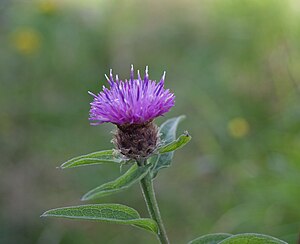Black knapweed
| Black knapweed | ||||||||||||
|---|---|---|---|---|---|---|---|---|---|---|---|---|

Black knapweed ( Centaurea nigra ) |
||||||||||||
| Systematics | ||||||||||||
|
||||||||||||
| Scientific name | ||||||||||||
| Centaurea nigra | ||||||||||||
| L. |
The Centaurea nigra ( Centaurea nigra , Syn. : Centaurea jacea L. . Subsp nigra (L.) Bonnier & Layens ., Including Centaurea nemoralis Jordan ) is a plant from the genus of knapweed ( Centaurea ) in the subfamily of Carduoideae within the family the daisy family (Asteraceae).
description
Vegetative characteristics
The black knapweed grows as perennial herbaceous plants and reaches heights of 20 to 80 centimeters. It forms stems with few branches . The leaves are lanceolate to oval.
Generative characteristics
The flowering period extends from July to September. Below the flower heads, the stems are clearly visible thickened to a few centimeters. The bracts have black, comb-shaped appendages. The cup-shaped inflorescences are between 2.5 and 3.5 centimeters in diameter and contain only purple tubular flowers . In contrast to other types of knapweed such. B. the meadow knapweed and the scabiosa knapweed , the marginal flowers are not enlarged.
The about 3 mm long achenes have an about 1 mm long pappus made of dark bristles.
The number of chromosomes is 2n = 22 or 24.
Occurrence
The black knapweed has areas in Western Europe , including the British Isles , from the Iberian Peninsula to Norway , Sweden , France , Germany , Switzerland , Italy and the areas of the former Yugoslavia . It is also native to Morocco. It is a neophyte in North America, Chile, Australia and New Zealand. The black knapweed can be found in Europe on forest edges and heaths . It is a character species of the violion caninae association, but also occurs in the Geranio-Trisetetum or in the montane Arrhenatheretum.
Centaurea nigra is considered an invasive plant in the USA .
Systematics
One can distinguish the following subspecies:
- Centaurea nigra subsp. aterrima (Hayek) Hayek : It was described from Bosnia-Herzegovina.
- Centaurea nigra subsp. carpetana (Boiss. & Reut.) Nyman : It occurs in Spain and France.
- Centaurea nigra subsp. nigra
- Centaurea nigra subsp. rivularis (bread.) Cout. : It occurs in Portugal, Spain and Great Britain.
use
The flowers can be used to decorate salads and be eaten.
Roots and seeds are used medicinally. The effect is sweat and diuretic . Today and especially in the past, this type of plant was used for wound healing.
literature
- Dietmar and Renate Aichele, Heinz-Werner Schwegler: What is green and blooming in nature? Recognize 700 flowering plants from color photos. Kosmos Verlags-GmbH Stuttgart 1986, ISBN 3-440-04931-0
Individual evidence
- ↑ a b Erich Oberdorfer : Plant-sociological excursion flora for Germany and neighboring areas . With the collaboration of Angelika Schwabe and Theo Müller. 8th, heavily revised and expanded edition. Eugen Ulmer, Stuttgart (Hohenheim) 2001, ISBN 3-8001-3131-5 , pp. 971 .
- ^ A b Centaurea in the Germplasm Resources Information Network (GRIN), USDA , ARS , National Genetic Resources Program. National Germplasm Resources Laboratory, Beltsville, Maryland. Retrieved March 29, 2018.
- ↑ a b c d Werner Greuter (2006+): Compositae (pro parte majore). - In: W. Greuter & E. von Raab-Straube (ed.): Compositae. Euro + Med Plantbase - the information resource for Euro-Mediterranean plant diversity. Datasheet Centaurea nigra In: Euro + Med Plantbase - the information resource for Euro-Mediterranean plant diversity.
Web links
- Centaurea nigra at Plants For A Future
- Centaurea nigra in the Germplasm Resources Information Network (GRIN), USDA , ARS , National Genetic Resources Program. National Germplasm Resources Laboratory, Beltsville, Maryland.
- David J. Keil, Jörg Ochsmann: Centaurea. : Centaurea nigra , p. 187 - online with the same text as the printed work , In: Flora of North America Editorial Committee (Ed.): Flora of North America North of Mexico. Volume 19: Magnoliophyta: Asteridae, part 6: Asteraceae, part 1 (Mutisieae – Anthemideae) , Oxford University Press, New York and Oxford, 2006, ISBN 0-19-530563-9 .
- Distribution map for Germany. In: Floraweb .
- Distribution in the northern hemisphere

